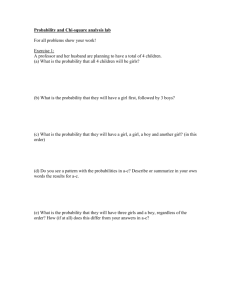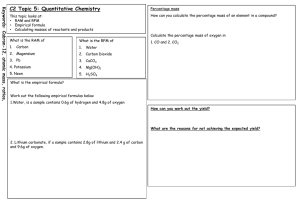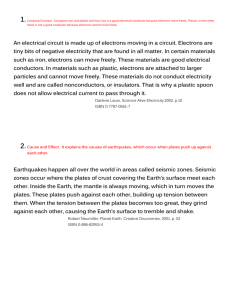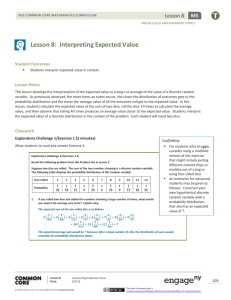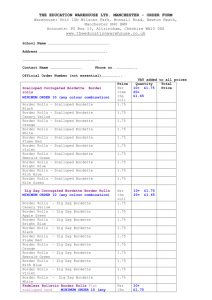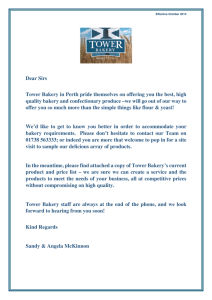2. A peach tree will yield 100 pounds of peaches now, which will sell
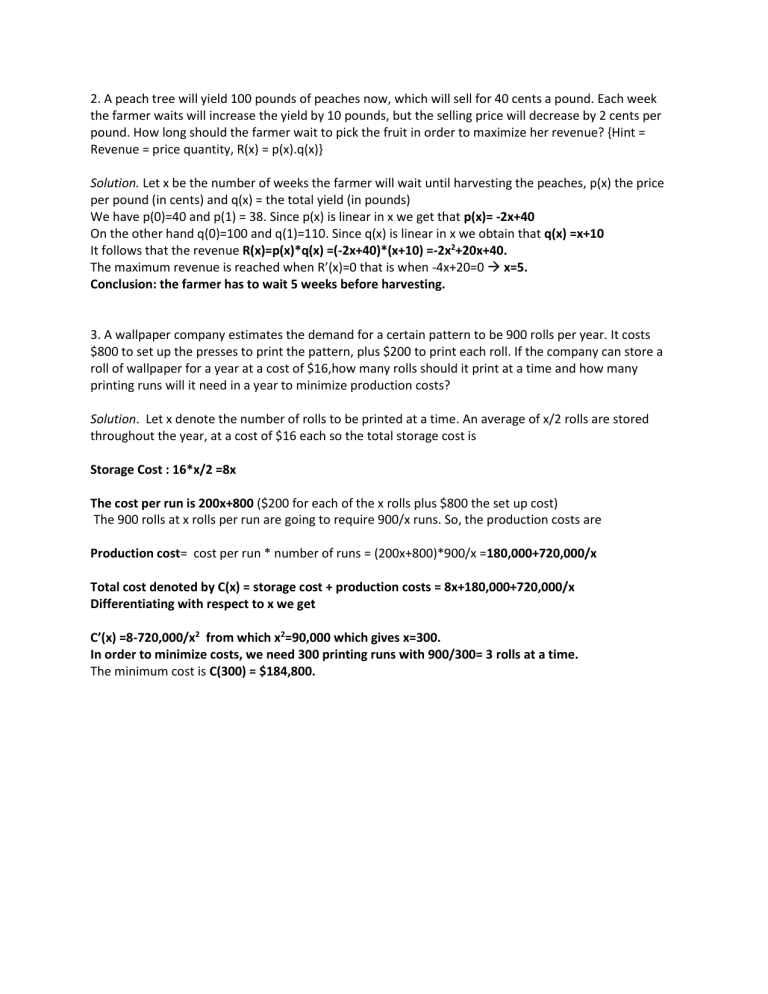
2. A peach tree will yield 100 pounds of peaches now, which will sell for 40 cents a pound. Each week the farmer waits will increase the yield by 10 pounds, but the selling price will decrease by 2 cents per pound. How long should the farmer wait to pick the fruit in order to maximize her revenue? {Hint =
Revenue = price quantity, R(x) = p(x).q(x)}
Solution. Let x be the number of weeks the farmer will wait until harvesting the peaches, p(x) the price per pound (in cents) and q(x) = the total yield (in pounds)
We have p(0)=40 and p(1) = 38. Since p(x) is linear in x we get that p(x)= -2x+40
On the other hand q(0)=100 and q(1)=110. Since q(x) is linear in x we obtain that q(x) =x+10
It follows that the revenue R(x)=p(x)*q(x) =(-2x+40)*(x+10) =-2x 2 +20x+40.
The maximum revenue is reached when R’(x)=0 that is when -4x+20=0 x=5.
Conclusion: the farmer has to wait 5 weeks before harvesting.
3. A wallpaper company estimates the demand for a certain pattern to be 900 rolls per year. It costs
$800 to set up the presses to print the pattern, plus $200 to print each roll. If the company can store a roll of wallpaper for a year at a cost of $16,how many rolls should it print at a time and how many printing runs will it need in a year to minimize production costs?
Solution. Let x denote the number of rolls to be printed at a time. An average of x/2 rolls are stored throughout the year, at a cost of $16 each so the total storage cost is
Storage Cost : 16*x/2 =8x
The cost per run is 200x+800 ($200 for each of the x rolls plus $800 the set up cost)
The 900 rolls at x rolls per run are going to require 900/x runs. So, the production costs are
Production cost= cost per run * number of runs = (200x+800)*900/x =180,000+720,000/x
Total cost denoted by C(x) = storage cost + production costs = 8x+180,000+720,000/x
Differentiating with respect to x we get
C’(x) =8-720,000/x 2 from which x 2 =90,000 which gives x=300.
In order to minimize costs, we need 300 printing runs with 900/300= 3 rolls at a time.
The minimum cost is C(300) = $184,800.
4. A motorcycle shop estimates that it will sell 500 motorbikes in a year. Each bike costs $300,plus a fixed charge of $500 per order. If it costs $200 to store a motorbike for a year, what is the order size and how many orders will be needed in a year to minimize inventory costs?
Solution. Let x denote the number of bikes to be ordered at a time. An average of x/2 bikes are stored throughout the year, at a cost of $200 each so the total storage cost is
Storage Cost : 200*x/2 =100x
The cost per order is 300x+500 ($300 for each of the x bikes plus $500 the fixed charge)
The 500 bikes at x bikes per order are going to require 500/x orders. So, the order costs are
Order cost= cost per order * number of orders = (300x+500)*500/x =150,000+250,000/x
Total cost denoted by C(x) = storage cost + order costs = 100x+150,000+250,000/x
Differentiating with respect to x we get
C’(x) =100-250,000/x 2 from which x 2 =2,500 which gives x=50.
In order to minimize costs, we need 50 orders with 500/50= 10 bikes at a time.
The minimum cost is C(50) = $160,000
5.The reproduction function for the Canadian snowshoe hare is estimated to be f(p) = -0.025p
2 +4p
,where p and f(p) are in thousands. Find the population that gives the maximum sustainable yield and the size of the yield.
Solution. Y(p) =f(p)-p =-0.0025p
2 +4p-p =-0.0025p
2 +3p
The yield is maximized when its derivative is zero that is Y’(p) =-0.005p+3 =0 p=600
It follows that Y(600)= 900.
So the population that gives the maximum sustainable yield is 600 and the size of this maximum yield is 900.
